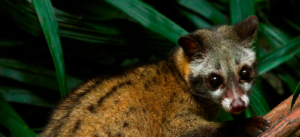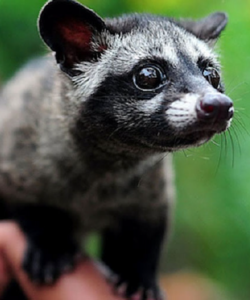Sentral ng Pilipinas launched its New Generation Currency notes in 2010, it took the opportunity to feature some of the country’s most prominent indigenous species alongside its local environment. On the reverse side of the twenty-peso bill, one finds the Cordillera region, as represented by the Banaue Rice Terraces and the palm civet (Paradoxorus hermaphrodites philippinensis), an unintentionally ironic gesture, given the creature’s reputation as the producer of the most expensive coffee in the world.
Region and Habitat
Unlike a considerable number of species located in the Philippines, the palm civet is neither endemic nor endangered. The Asian palm civet species can be found in various regions within Asia, including but not limited to Sri Lanka, Thailand, Vietnam, Cambodia, Malaysia, Indonesia, Laos, Nepal, and Singapore. It is the most common mammalian carnivore in Palawan, but can also be found in many provinces, including but not limited to Batangas, Cavite, South Cotabato, Samar, Panay, Benguet, and Kalinga Apayao.

The palm civet is a resilient animal, able to thrive in a variety of environments, for as long as these locations afford enough food and shelter; they are arboreal creatures, and prefer spending their time in tree canopies of up to 2,000 feet. Palm civets have been found in temperate and tropical forests, and even in more developed or manmade areas such as plantations, parks, and gardens.Characteristics and behaviorKnown locally as alamid, musang, or motit, the palm civet goes by weasel cat in other parts of the world for its resemblance to these two animals. Its facial features resemble that of a cat, but with longer, flatter skulls, large dark eyes and pointed ears. Like a weasel, its body is lean and elongated, with short legs and a very long tail. Palm civets have short, coarse coats: with banded facial markings like a raccoon and dark stripes down their back and three rows of black spots on their body and legs.
Palm civets have plantigrade feet and walk with their entire sole touching the ground.Palm civets lead nocturnal, solitary lives: they are generally more active at dusk―especially during darker nights― and rest in tree hollows or rock crevices during the day.
Their reproductive behavior has only been observed in a zoo setting: breeding occurs year round, with civets occupying the same trees and mating for up to fifteen days.Palm civets subsist on an omnivorous diet, being hunters and foragers. They stalk small mammals like rats and mice from a distance and pounce from a distance, scavenge the ground for worms and snails, or climb from tree to tree picking fruit. They have been known to favor the fruits of the palm tree―hence the name―as well as chico, mango, bananas, rambutan, and papaya, often selecting the ripest fruits for consumption.

They also drink the nectar of silk cotton trees and the sap of sugar palm flowers, earning them another nickname, the toddy cat. But the food item they are most famous for ingesting is not even their major source of nutrition: the coffee cherry.Coffee controversyWhen palm civets ingest coffee cherries, they are able to digest the fleshy pulp, but not the hard coffee bean at the center―this gets fermented in stomach enzymes and is eventually excreted intact in civet feces. Gathered, washed, and lightly roasted, these beans are transformed into the costly and controversial civet coffee (called kopi luwak in Indonesia and kapeng alamid in the Philippines), certain brands of which can fetch up to $10,0000 in luxury department stores. The exorbitant price is justified by claims of superior taste and rarity. Connoisseurs claim that the light roast brings out the bean’s chocolate and caramel tones, as well as its nutty, earthy oaky flavors, while suppliers describe the difficulty of obtaining bean supply, given the time-consuming task of scouring the civets’ forest habitat for excreted coffee beans.
But reports from various sources, including People for the Ethical Treatment of Animals (PETA) and former coffee trader and kopi luwak trendsetter Tony Wild claim that the booming demand has resulted in the inhumane treatment of palm civets, now held captive in cramped conditions and forced to subsist on a diet consisting primarily of coffee cherries. Moreover, issues have also been raised regarding the safety of ingesting authentic civet coffee beans harvested in the wild, which may or may not be infected with fungi.
Fun Facts About Palm Civets

1) Palm civets are small mammals, averaging 3 kilograms in weight, 50 cm in length, and an additional 48 cm in tail length.
2) Unlike other civets, palm civets have neck hair that grow backwards.
3) Despite their scientific name, palm civets are not really hermaphroditic. Rather, both sexes have a perineal scent gland resembling testicles. Located under their tail, the gland is used to spray in defense, mark territory, or communicate with other species. Scent markings and response are the civet’s primary means of communication.
4) The palm civet’s nocturnal and arboreal characteristics are believed to have evolved as a means of avoiding predators.
5) The solitary civet usually spends most of his adult life within its territory, ranging from 1.4 to 50 square kilometers, only going beyond when there is a scarcity of food.
6) Before kopi luwak or kape alamid became a gourmet delicacy, palm civets were valued as rodent catchers or as producers of civet oil. While previously used to treat scabies, their musk is now used for perfume. The musk can be produced when the civet is harassed or under stress, and obtaining it requires a special scraping tool that may be painful for the civet.
7) By eating and excreting the seeds of fruit trees, palm civets contribute to seed dispersal and forest regeneration.
8) While categorized under “Least Concern” in the IUCN Red List of Threatened Species, palm civets are also hunted for their meat, particularly in South China and India. Civet meat is also considered a delicacy in the Cordillera region, where it is dried and prepared adobo-style.
9) Palm civets have a lifespan of fifteen to twenty years in the wild; civets living in captivity have been recorded to survive twenty four years.
10) The Philippine eagle is a known predator of the palm civet.
More detailed information on the palm civet can be found at:
http://animaldiversity.org/accounts/Paradoxurus_hermaphroditus/
http://www.iucnredlist.org/details/41693/0
This appeared as “Animals 101: Palm Civet” in Animal Scene’s February 2015 issue.






